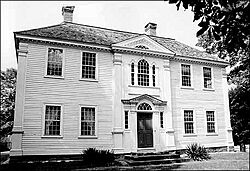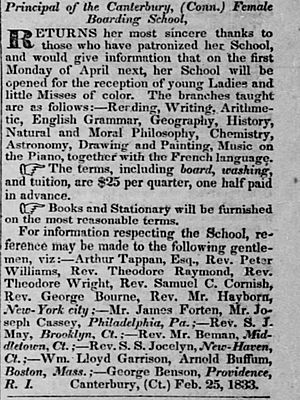Canterbury Female Boarding School facts for kids
Quick facts for kids Canterbury Female Boarding School |
|
|---|---|

Site of Canterbury Female Boarding School, now the Prudence Crandall Museum.
|
|
| Location | |
|
1 South Canterbury Road
Canterbury, Connecticut 06331 United States
|
|
| Coordinates | 41°41′53″N 71°58′18″W / 41.698130°N 71.971610°W |
| Information | |
| Other name | School for Young Ladies and Little Misses of Color |
| Type | Boarding |
| Established | October 1831 |
| Founder | Prudence Crandall |
| Closed | September 10, 1834. Closed briefly in March 1833 as it converted into a school for African-American "young ladies and little misses of color", which reopened April 1833. |
| Principal | Prudence Crandall |
| Staff | Mariah Davis |
| Faculty | Prudence Crandall, her sister Almira Crandall, Samuel May, William Burleigh |
| Gender | Female |
| Enrollment | 24 |
| Campus type | Large house on Canterbury town square |
| Supporters | William Lloyd Garrison, Rev. Simeon Jocelyn, Rev. Samuel J. May, Arthur Tappan |
| Enemies | Andrew T. Judson |
| Relevant legislation | Connecticut Black Law, passed May 24, 1833, repealed 1838, prohibiting educating African Americans not from Connecticut, who were not citizens and did not have rights. |
| Legal issue | Whether African Americans were citizens |
| Supreme Court references | Dred Scott v. Sandford, Brown v. Board of Education |
The Canterbury Female Boarding School was a school in Canterbury, Connecticut. It was started by Prudence Crandall in 1831. At first, it was for white girls. But when a young African-American girl, Sarah Harris, wanted to join, the townspeople said no.
Prudence Crandall then made a brave decision. She changed her school to be only for African-American girls. This was the first school of its kind in the United States. The state of Connecticut even passed a law against it. Crandall was arrested and spent a night in jail, which brought national attention to her school. Sadly, violence from the community forced her to close the school in 1834.
This event was a very important moment in the history of school desegregation in the United States. The legal case, Crandall v. State, even helped shape later important Supreme Court decisions. These included Dred Scott v. Sandford in 1857 and Brown v. Board of Education in 1954.
Contents
Starting the School in Canterbury
In 1831, the town of Canterbury needed a school for girls. They asked Prudence Crandall, a well-educated Quaker teacher, to open one. She was teaching in a nearby town called Plainfield.
Prudence agreed and bought a large house in the town square for the school. It was next to the home of a lawyer named Andrew T. Judson. He was a supporter at first but later became a strong opponent.
The school opened in November 1831. It was very popular and successful. Prudence Crandall quickly paid off the loan for the house. The school soon had 24 students, which was its full capacity. Students learned subjects like reading, writing, math, history, and science.
Sarah Harris Joins the School
In late 1831, Prudence Crandall hired Mariah Davis, a young African-American woman, to help around the school. Mariah's fiancé was connected to The Liberator, an abolitionist newspaper. Prudence read the newspaper and became very interested in the idea of ending slavery.
Mariah introduced Prudence to her fiancé's sister, Sarah Harris. In November 1832, Sarah asked Prudence if she could attend the school. Sarah wanted to become a teacher for African-American students. Prudence thought about it and decided to let Sarah join as a day student. This made it the first integrated school in the United States, meaning it had both white and black students.
Many important people in Canterbury did not like this. They told Prudence to make Sarah leave the school. But Prudence refused. She said she would not turn Sarah out, even if it meant the school would close. Prudence truly liked Sarah Harris.
Townspeople Oppose the School
The people of Canterbury were very upset that Prudence Crandall was educating black and white students together. They were shocked and worried. A group of townspeople met with Prudence. They tried to convince her to change her mind. They even hinted at problems that might come from "mixing races." But Prudence stood firm. She said, "Moses had a black wife," showing that people of different backgrounds had been together before.
Because of her refusal, the school immediately lost the support of the town. Parents began to take their daughters out of the school. They were afraid of what might happen.

Prudence realized she had to do something for the school to survive. She decided to change her school to serve only "young Ladies and little Misses of color." There was no other school like this in the United States. She traveled to Boston to talk with William Lloyd Garrison, who edited The Liberator. He encouraged her and helped her connect with people who might be interested.
Prudence then visited New York and Rhode Island to see if there was enough interest. She found that many families wanted such a school. So, she decided to close her current school and reopen it just for black girls. She announced this to her students on February 25, 1833. An advertisement in The Liberator on March 2, 1833, said the new school would open on April 1.
The town reacted with fear. Andrew Judson, who believed free black people should leave the United States and go to Africa, urged the townspeople on. They worried that Canterbury would become a place where many free black people would gather. They thought this would be a threat to the country. They believed educating black people would lead to more problems for the state.
A School for Girls of Color Opens
The school reopened as planned with about ten to twelve "quiet, harmless little colored girls." They came from good families in northern cities. A visitor in June said there were 17 girls who were very well-behaved. Soon, the school had 24 students. They came from places as far away as Philadelphia.
Students came from different states, including:
- Connecticut:
* Sarah Harris Fayerweather * Mary Harris (Sarah's sister) * Harriet Roselle Lanson * Eliza and Miranda Glasgow * Mariah Davis
- Other States:
* Theodosia DeGrasse (from New York) * Ann Eliza Hammond (from Providence, Rhode Island) * Ann Peterson * Julia Williams (from Boston) * Ann Elizabeth Wilder (from New York)
The school taught the same subjects as before, except for rhetoric.
New Laws and Harassment
On May 24, 1833, the state of Connecticut passed a new law called the Black Law. Andrew Judson helped write this law. It said that no one could run a school for African Americans from outside Connecticut without the town's permission. The law also said that anyone who broke it would have to pay a fine.
After this law passed, the townspeople refused to have anything to do with the school. They tried to make life difficult for Prudence and her students.
- Storekeepers, butchers, and milk sellers refused to sell them food.
- When Prudence's family brought supplies, they were insulted.
- The school's well was filled with dirt, and neighbors refused to give them water.
- The town doctor refused to treat sick students.
- Vandals even tried to hurt visitors' horses.
Prudence Crandall did not follow the new law. She was arrested and spent one night in jail. She could have paid a small fine to avoid jail, but she refused. She wanted to show how unfair the law was. People across the country heard about her arrest. Newspapers, like the Boston Advocate, wrote about how shocking it was that a teacher was put in jail.
Another teacher, Andrew Burleigh, was also arrested in 1834. But the charges against him were dropped when the school closed.
Prudence Crandall's Trials
Prudence Crandall's first trial began on August 23, 1833. She said she was "not guilty." Her lawyers were William W. Ellsworth, Calvin Goddard, and Henry W. Strong. They were paid by a supporter named Arthur Tappan. Andrew Judson led the lawyers trying to convict her. The jury could not agree on a decision.
A second trial started on October 3, 1833, at the Connecticut Supreme Court. Judge David Daggett was in charge. He was known to be against African Americans and supported the Black Law. Judge Daggett told the jury that African Americans were not "citizens" under the Constitution. The jury quickly found Prudence "guilty."
Her lawyers immediately appealed this decision to a higher court, the Connecticut Supreme Court (Court of Errors). The appeal was argued on July 22, 1834. Many people were very interested in the case. However, the court avoided making a decision about whether the law was fair. They found a small mistake in the legal papers, which allowed them to avoid ruling on the main issue. They did not want to upset the public by deciding in her favor or by saying the law was unconstitutional.
Prudence continued to run the school during this time. She even thought about moving the school to Philadelphia. But she heard about recent violence against black people there and decided against it.
School Closes Due to Violence
When the legal actions did not close the school, the townspeople tried other ways. They tried to set the school building on fire, but they failed. Finally, on September 9, 1834, a group of people broke into the school. They used heavy clubs and iron bars. They broke many windows and scared the students.
Prudence Crandall was worried about her students' safety. On the advice of her friend Samuel May, she closed the school. She left Connecticut and never lived there again. Samuel May wrote that he felt "ashamed of Canterbury, ashamed of Connecticut, ashamed of my country."
The Impact of the School
The story of Prudence Crandall's school was told widely. People in other countries, like England, called Crandall "glorious." An English abolitionist named Charles Stuart even sent gifts to the girls.
To help share the story, Samuel May started a newspaper called The Unionist. It was published in Brooklyn, Connecticut, and focused on the situation.
This widely known event was one of the first times that groups of people attacked those who were against slavery. It made many people even more committed to ending slavery. It also showed that the idea of sending free black people to Africa was not a good solution. The case also brought up important questions about the rights of free black people in the North. These questions were later addressed in the Fourteenth Amendment.
Andrew Judson, who led the opposition, lost his election for the Connecticut legislature in 1834. This surprised his supporters and made those against slavery very happy. After these events, Windham County became the most anti-slavery part of Connecticut.
Notable Students
Legacy of the School
- A book called The Canterbury Question was published in 2014.
- A play about the school, Bondage : a drama of Prudence Crandall's Canterbury school, was performed in 1936.
Images for kids



